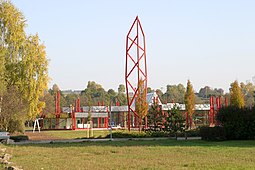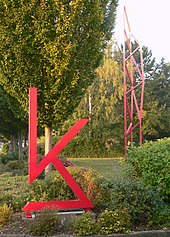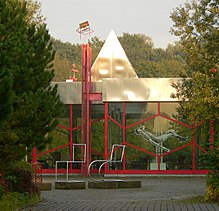Tecta Cantilever Chair Museum
|
TECTA cantilever chair museum |
|
| Data | |
|---|---|
| place |
Lauenförde |
| Art |
Museum of Furniture Design
|
| architect | Peter Smithson |
| opening | 1979 |
| operator | |
| management |
Daniela Drescher
|
| Website | |
The Tecta Kragstuhlmuseum is a private museum for furniture design of the Modern in Lauenförde in the district of Holzminden in Lower Saxony . The museum shows a comprehensive collection on the history of modern furniture design with a focus on the development of the cantilever chair .
history
The museum was founded in 1979 by Axel Bruchhäuser, a co-owner of the furniture manufacturer Tecta , as the "Chair Museum Burg Beverungen " in Beverungen in the Höxter district in North Rhine-Westphalia . It has been in Lauenförde since 2004.
Collections
The Kragstuhlsammlung in museum documents with around 1,000 exhibits, the development of the "behind legless chair" of the rigid cantilever structure to the resilient cantilever . The spectrum of the exhibited artists ranges from Walter Gropius , El Lissitzky , Mart Stam , Marcel Breuer , Alvar Aalto and Gerrit Rietveld to Ludwig Mies van der Rohe to Alison and Peter Smithson and Stefan Wewerka . The museum has the Jean Prouvé archive , which, with over 100 originals, illustrates the design principles of the French engineer and architect. The collection of Urmodelle der Moderne includes chair originals from Schinkel's cast iron chairs to Wewerka's designs from the 1980s. The Anonymous Aristocrats Collection contains finds by unknown designers that are in no way inferior to those of their famous contemporaries. The Alison and Peter Smithson Archives and the Wewerka Studio contain drafts, prototypes and series products that were created in collaboration with the furniture manufacturer Tecta.
architecture
The cantilever chair museum with three exhibition halls and a small service building is located together with the Tecta production buildings in a landscape park created from 1984 . On September 29, 2003, the museum's first exhibition hall was opened. In 2004 another section was completed. The third exhibition hall was completed in August 2007.
The entrance to the museum is marked by a 15 meter high red tower made of steel framework . The most conspicuous element of the museum building are its raised external supports, at the tips of which 10 cantilever chairs are mounted in idiosyncratic positions. The expressive installation is called “The ten chairs of Lauenförde”.
The structure of the museum is made visible steel supporting structure , which is red on the outside and inside painted white. The all-round glazing ensures the exhibition is illuminated and the building can be viewed without restriction. The style of the building can be assigned to brutalism . The floor plan of the building forms a striking zigzag figure, which allows individual niches to emerge, in which exhibition groups with related content are arranged. “The language of the individual chairs is supported by the respective 'companions',” said Smithson, describing his intention.
A diagonally laid track on which a draisine-like car drives runs through the exhibition halls and across the museum grounds . The rail connects the indoor and outdoor spaces as an architectural reference to the industrial background of the exhibits.
The museum building is the last work of the British architect Peter Smithson , which he designed together with his wife Alison . The design historian Jörg Stürzebecher counts the cantilever chair museum in the ensemble with other buildings by Smithson, such as the Tecta factory site and a house in Bad Karlshafen, among the most important architectural works of post-war modernism in Europe.
literature
- Axel Bruchhäuser: The cantilever chair. Cantilever chair collection - Jean Prouvé archive - master models of modernity . Ed .: Chair Museum Burg Beverungen. Revised and supplemented edition. Walter König, Cologne 1998, ISBN 3-88375-351-3 .
- Peter Smithson, Karl Unglaub: Flying furniture. Our architecture rolls, swims, flies = our architecture rolls, swims, flies . Walther König, Cologne 2000, ISBN 3-88375-405-6 .
- Lauenforde at the Weser cantilever chair museum . In: Bauwelt . tape 95 , April 8, 2004, ISSN 0005-6855 , p. 2 .
- P. Smithson: Cantilever Chair Museum / Tecta Archive Lauenforde Legacy - Last Work of the Architect . In: Glasforum - Architecture, Space Art, Use . No. 10 , 2004, ISSN 0017-0852 , p. 5-7 .
- Karl Unglaub: Cantilever tables . Walther König, Cologne 2005, ISBN 3-88375-692-X .
- History of a German company. Tecta Axel + Werner Bruchhäuser KG as a special print from: Güstrow im Umbruch , ed. Angelika Schmiegelow Powell, Edition Temmen , Bremen, 2003
Web links
- Website of the cantilever chair museum / Tecta archive Lauenförde
- Building description of the cantilever chair museum at Baunetz Wissen.de
- Carsten Krohn: Manifesto for the building of the cantilever chair museum in Zürcher Zeitung from January 7, 2004
- What actually is: the Cantilever Chair Museum? at CDU Kreisverband Holzminden on May 2, 2016
Individual evidence
- ^ The redesign of the cantilever chair museum in Neue Westfälische on April 29, 2016
- ↑ Searching for traces of British Pop Art in Lauenförde in Neue Westfälische from October 20, 2016



